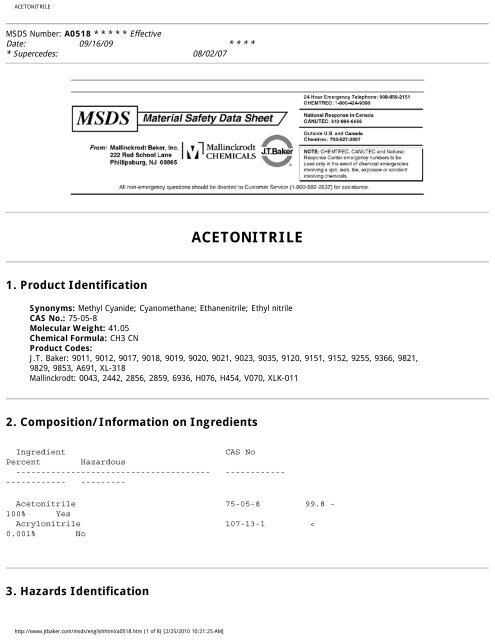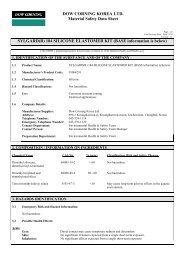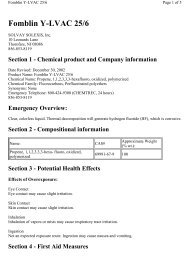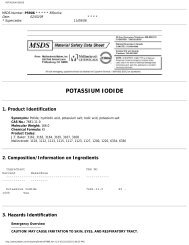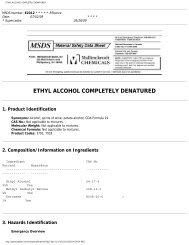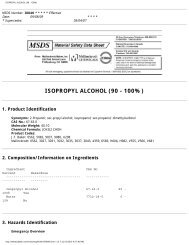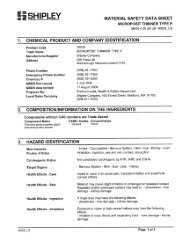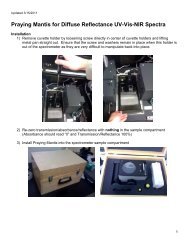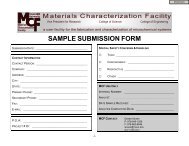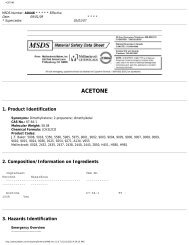ACETONITRILE
Acetonitrile (CH 3 CN) - Materials Characterization Facility
Acetonitrile (CH 3 CN) - Materials Characterization Facility
- No tags were found...
You also want an ePaper? Increase the reach of your titles
YUMPU automatically turns print PDFs into web optimized ePapers that Google loves.
<strong>ACETONITRILE</strong><br />
MSDS Number: A0518 * * * * * Effective<br />
Date: 09/16/09 * * * *<br />
* Supercedes: 08/02/07<br />
<strong>ACETONITRILE</strong><br />
1. Product Identification<br />
Synonyms: Methyl Cyanide; Cyanomethane; Ethanenitrile; Ethyl nitrile<br />
CAS No.: 75-05-8<br />
Molecular Weight: 41.05<br />
Chemical Formula: CH3 CN<br />
Product Codes:<br />
J.T. Baker: 9011, 9012, 9017, 9018, 9019, 9020, 9021, 9023, 9035, 9120, 9151, 9152, 9255, 9366, 9821,<br />
9829, 9853, A691, XL-318<br />
Mallinckrodt: 0043, 2442, 2856, 2859, 6936, H076, H454, V070, XLK-011<br />
2. Composition/Information on Ingredients<br />
Ingredient<br />
CAS No<br />
Percent Hazardous<br />
--------------------------------------- ------------<br />
------------ ---------<br />
Acetonitrile 75-05-8 99.8 -<br />
100% Yes<br />
Acrylonitrile 107-13-1 <<br />
0.001% No<br />
3. Hazards Identification<br />
http://www.jtbaker.com/msds/englishhtml/a0518.htm (1 of 8) [2/25/2010 10:21:25 AM]
<strong>ACETONITRILE</strong><br />
Emergency Overview<br />
--------------------------<br />
DANGER! MAY BE FATAL IF SWALLOWED, INHALED OR ABSORBED THROUGH SKIN.<br />
AFFECTS CARDIOVASCULAR SYSTEM, CENTRAL NERVOUS SYSTEM, LIVER AND<br />
KIDNEYS. FLAMMABLE LIQUID AND VAPOR. MAY CAUSE IRRITATION TO SKIN, EYES,<br />
AND RESPIRATORY TRACT.<br />
SAF-T-DATA (tm) Ratings (Provided here for your convenience)<br />
-----------------------------------------------------------------------------------------------------------<br />
Health Rating: 3 - Severe (Life)<br />
Flammability Rating: 3 - Severe (Flammable)<br />
Reactivity Rating: 1 - Slight<br />
Contact Rating: 3 - Severe (Life)<br />
Lab Protective Equip: GOGGLES & SHIELD; LAB COAT & APRON; VENT HOOD; PROPER GLOVES; CLASS<br />
B EXTINGUISHER<br />
Storage Color Code: Red (Flammable)<br />
-----------------------------------------------------------------------------------------------------------<br />
Potential Health Effects<br />
----------------------------------<br />
In most cases, cyanide poisoning causes a deceptively healthy pink to red skin color. However, if a physical<br />
injury or lack of oxygen is involved, the skin color may be bluish. Reddening of the eyes and pupil dilation<br />
are symptoms of cyanide poisoning. Cyanosis (blue discoloration of the skin) tends to be associated with<br />
severe cyanide poisonings.<br />
Inhalation:<br />
Effects of overexposure are often delayed, possibly due to the slow formation of cyanide anions in the body.<br />
These cyanide anions prevent the body from using oxygen and can lead to internal asphyxiation. Early<br />
symptoms may include nose and throat irritation, flushing of the face, and chest tightness. Higher<br />
concentrations may produce headache, nausea, vomiting, respiratory depression, weakness, blood<br />
changes, thyroid changes, irregular heart beat, abdominal pain, convulsions, shock, unconsciousness and<br />
death, depending on concentration and time of exposure. This highly toxic material has insufficient<br />
warning properties to prevent personnel from working in contaminated atmospheres.<br />
Ingestion:<br />
Gastric irritation may occur. Other symptoms parallel those from inhalation exposure.<br />
Skin Contact:<br />
May cause irritation. May be absorbed through skin with health effects to parallel those of inhalation.<br />
Eye Contact:<br />
Splashes may cause eye irritation with redness and pain.<br />
Chronic Exposure:<br />
Long term exposures may affect liver, kidneys, and central nervous system.<br />
Aggravation of Pre-existing Conditions:<br />
Workers using cyanide should have preplacement and periodic medical exams. Those with history of<br />
central nervous system, heart or lung diseases, or liver, kidney, or thyroid problems may be more susceptible<br />
to the effects of this substance.<br />
4. First Aid Measures<br />
FOLLOWING ANY ROUTE OF EXPOSURE GET MEDICAL ATTENTION IMMEDIATELY. SERIOUS TOXICITY<br />
IS PRECEDED BY VOMITING IN MOST CASES OF ORAL INGESTION.<br />
Although used in pre-hospital management of cyanide poisoning, amyl nitrite inhalants have not been shown to<br />
be beneficial in managing acetonitrile poisoning.<br />
Inhalation:<br />
If inhaled, remove to fresh air. If breathing is labored or with coughing, give 100% supplemental oxygen. If<br />
not breathing, begin artificial respiration. DO NOT GIVE MOUTH-TO-MOUTH RESUSCITATION.<br />
Ingestion:<br />
http://www.jtbaker.com/msds/englishhtml/a0518.htm (2 of 8) [2/25/2010 10:21:25 AM]
<strong>ACETONITRILE</strong><br />
If swallowed, get medical attention immediately; do not induce vomiting. Never give anything by mouth to<br />
an unconscious person. If not breathing, begin artificial respiration. DO NOT GIVE MOUTH-TO-<br />
MOUTH RESUSCITATION.<br />
Skin Contact:<br />
Immediately flush skin with plenty of water for at least 15 minutes while removing contaminated clothing<br />
and shoes. Get medical attention immediately. Wash clothing before reuse. Thoroughly clean shoes before reuse.<br />
Eye Contact:<br />
Immediately flush eyes with plenty of water for at least 15 minutes, lifting lower and upper eyelids<br />
occasionally. Get medical attention immediately.<br />
Note to Physician:<br />
Any patient with ingestion or other significant exposure to acetonitrile should be observed in the intensive care<br />
unit for 24 hours.<br />
In-Hospital Management:<br />
Consider gastric lavage if patient is presented soon after ingestion. Administer charcoal slurry with or without<br />
saline cathartic or sorbitol. Immediately begin therapy with 100% oxygen. Observe for respiratory<br />
depression, seizures, hypotension or pulmonary edema. Acetonitrile metabolizes into cyanide over 2 to 8 hours,<br />
so symptoms or signs of toxicity may be delayed after significant exposures. Consider cyanide antidote as<br />
clinically indicated, such as sodium thiosulfate and sodium nitrate. Monitor cyanide levels, arterial blood gases,<br />
and acid-base balance.<br />
5. Fire Fighting Measures<br />
Fire:<br />
Flash point: 2C (36F) CC<br />
Autoignition temperature: 524C (975F)<br />
Flammable limits in air % by volume:<br />
lel: 4.4; uel: 16.0<br />
Flammable Liquid and Vapor! Contact with strong oxidizers may cause fire.<br />
Explosion:<br />
Above flash point, vapor-air mixtures are explosive within flammable limits noted above. Vapors can flow<br />
along surfaces to distant ignition source and flash back. Sealed containers may rupture when heated. Sensitive<br />
to static discharge.<br />
Fire Extinguishing Media:<br />
Dry chemical, foam or carbon dioxide. Water spray may be used to keep fire exposed containers cool.<br />
Special Information:<br />
In the event of a fire, wear full protective clothing and NIOSH-approved self-contained breathing apparatus<br />
with full facepiece operated in the pressure demand or other positive pressure mode. If a leak or spill has<br />
not ignited, use water spray to disperse the vapors, to protect personnel attempting to stop leak, and to flush<br />
spills away from exposures. May emit toxic and flammable fumes of cyanide if involved in a fire.<br />
6. Accidental Release Measures<br />
Ventilate area of leak or spill. Remove all sources of ignition. Wear appropriate personal protective equipment<br />
as specified in Section 8. Isolate hazard area. Keep unnecessary and unprotected personnel from entering.<br />
Contain and recover liquid when possible. Use non-sparking tools and equipment. Collect liquid in an<br />
appropriate container or absorb with an inert material (e. g., vermiculite, dry sand, earth), and place in a<br />
chemical waste container. Do not use combustible materials, such as saw dust. Do not flush to sewer! If a leak<br />
or spill has not ignited, use water spray to disperse the vapors, to protect personnel attempting to stop leak, and<br />
to flush spills away from exposures. Spills can be reacted in an alkaline hypochlorite solution to produce<br />
cyanate and then neutralized. US Regulations (CERCLA) require reporting spills and releases to soil, water and<br />
air in excess of reportable quantities. The toll free number for the US Coast Guard National Response Center<br />
is (800) 424-8802.<br />
http://www.jtbaker.com/msds/englishhtml/a0518.htm (3 of 8) [2/25/2010 10:21:25 AM]
<strong>ACETONITRILE</strong><br />
J. T. Baker SOLUSORB® solvent adsorbent is recommended for spills of this product.<br />
7. Handling and Storage<br />
Protect against physical damage. Store in a cool, dry well-ventilated location, away from any area where the<br />
fire hazard may be acute. Outside or detached storage is preferred. Separate from incompatibles.<br />
Containers should be bonded and grounded for transfers to avoid static sparks. Storage and use areas should<br />
be No Smoking areas. Use non-sparking type tools and equipment, including explosion proof ventilation.<br />
Containers of this material may be hazardous when empty since they retain product residues (vapors,<br />
liquid); observe all warnings and precautions listed for the product. Do Not attempt to clean empty containers<br />
since residue is difficult to remove. Do not pressurize, cut, weld, braze, solder, drill, grind or expose<br />
such containers to heat, sparks, flame, static electricity or other sources of ignition: they may explode and<br />
cause injury or death.<br />
8. Exposure Controls/Personal Protection<br />
Airborne Exposure Limits:<br />
For Acetonitrile:<br />
-OSHA Permissible Exposure Limit (PEL):<br />
40 ppm (TWA)<br />
-ACGIH Threshold Limit Value (TLV):<br />
20 ppm (TWA), skin, A4 - not classifiable as a human carcinogen.<br />
Ventilation System:<br />
A system of local and/or general exhaust is recommended to keep employee exposures below the<br />
Airborne Exposure Limits. Local exhaust ventilation is generally preferred because it can control the emissions<br />
of the contaminant at its source, preventing dispersion of it into the general work area. Please refer to the<br />
ACGIH document, Industrial Ventilation,<br />
A Manual of<br />
Recommended Practices<br />
, most recent edition, for details.<br />
Personal Respirators (NIOSH Approved):<br />
If the exposure limit is exceeded and engineering controls are not feasible, wear a supplied air, fullfacepiece<br />
respirator, airlined hood, or full-facepiece self-contained breathing apparatus. Breathing air quality<br />
must meet the requirements of the OSHA respiratory protection standard (29CFR1910.134). This substance<br />
has poor warning properties. Where respirators are required, you must have a written program covering the<br />
basic requirements in the OSHA respirator standard. These include training, fit testing, medical approval,<br />
cleaning, maintenance, cartridge change schedules, etc. See 29CFR1910.134 for details.<br />
Skin Protection:<br />
Wear impervious protective clothing, including boots, gloves, lab coat, apron or coveralls, as appropriate,<br />
to prevent skin contact.<br />
Eye Protection:<br />
Use chemical safety goggles and/or a full face shield where splashing is possible. Maintain eye wash fountain<br />
and quick-drench facilities in work area.<br />
9. Physical and Chemical Properties<br />
Appearance:<br />
Clear, colorless liquid.<br />
Odor:<br />
Ether odor.<br />
Solubility:<br />
http://www.jtbaker.com/msds/englishhtml/a0518.htm (4 of 8) [2/25/2010 10:21:25 AM]
<strong>ACETONITRILE</strong><br />
Miscible in water.<br />
Specific Gravity:<br />
0.79 @ 15C/4C<br />
pH:<br />
No information found.<br />
% Volatiles by volume @ 21C (70F):<br />
100<br />
Boiling Point:<br />
81.6C (180F)<br />
Melting Point:<br />
-46C (-51F)<br />
Vapor Density (Air=1):<br />
1.4<br />
Vapor Pressure (mm Hg):<br />
73 @ 20C (68F)<br />
Evaporation Rate (BuAc=1):<br />
5.79<br />
10. Stability and Reactivity<br />
Stability:<br />
Stable under ordinary conditions of use and storage.<br />
Hazardous Decomposition Products:<br />
Burning may produce fumes of cyanide, carbon monoxide, carbon dioxide, nitrogen oxides and sulfur oxides.<br />
Hazardous Polymerization:<br />
Will not occur.<br />
Incompatibilities:<br />
Incompatible with oxidizing materials, sulfuric acid, oleum, chlorosulfonic acid, n-fluoro compounds,<br />
nitrating agents and perchlorates.<br />
Conditions to Avoid:<br />
Heat, flames, ignition sources and incompatibles.<br />
11. Toxicological Information<br />
Oral rat LD50: 2460 mg/kg; skin rabbit LD50: 1250 uL/kg; inhalation rat LC50: 7551 ppm/8H. Investigated as<br />
a tumorigen, mutagen, reproductive effector.<br />
--------\Cancer Lists\------------------------------------------------------<br />
---NTP Carcinogen---<br />
Ingredient Known Anticipated IARC Category<br />
------------------------------------ ----- ----------- -------------<br />
Acetonitrile (75-05-8) No No None<br />
Acrylonitrile (107-13-1) No Yes 2B<br />
12. Ecological Information<br />
Environmental Fate:<br />
When released into the soil, this material may biodegrade to a moderate extent. When released into the soil,<br />
this material is expected to leach into groundwater. When released into the soil, this material may evaporate to<br />
a moderate extent. When released into water, this material may biodegrade to a moderate extent. When<br />
http://www.jtbaker.com/msds/englishhtml/a0518.htm (5 of 8) [2/25/2010 10:21:25 AM]
<strong>ACETONITRILE</strong><br />
released into water, this material may evaporate to a moderate extent. This material has an<br />
estimated bioconcentration factor (BCF) of less than 100. This material is not expected to<br />
significantly bioaccumulate. When released into the air, this material is not expected to react with<br />
photochemically produced hydroxyl radicals. When released into the air, this material may be removed from<br />
the atmosphere to a moderate extent by wet deposition. When released into the air, this material is expected<br />
to have a half-life of greater than 30 days.<br />
Environmental Toxicity:<br />
This material is not expected to be toxic to aquatic life. The LC50/96-hour values for fish are over 100 mg/l.<br />
13. Disposal Considerations<br />
Whatever cannot be saved for recovery or recycling should be handled as hazardous waste and sent to a<br />
RCRA approved waste facility. Processing, use or contamination of this product may change the<br />
waste management options. State and local disposal regulations may differ from federal disposal<br />
regulations. Dispose of container and unused contents in accordance with federal, state and local requirements.<br />
14. Transport Information<br />
Domestic (Land, D.O.T.)<br />
-----------------------<br />
Proper Shipping Name: <strong>ACETONITRILE</strong><br />
Hazard Class: 3<br />
UN/NA: UN1648<br />
Packing Group: II<br />
Information reported for product/size: 350LB<br />
International (Water, I.M.O.)<br />
-----------------------------<br />
Proper Shipping Name: <strong>ACETONITRILE</strong><br />
Hazard Class: 3<br />
UN/NA: UN1648<br />
Packing Group: II<br />
Information reported for product/size: 350LB<br />
15. Regulatory Information<br />
--------\Chemical Inventory Status - Part 1\---------------------------------<br />
Ingredient TSCA EC Japan Australia<br />
----------------------------------------------- ---- --- ----- ---------<br />
Acetonitrile (75-05-8)<br />
Yes Yes<br />
Yes Yes<br />
Acrylonitrile (107-13-1)<br />
Yes Yes<br />
Yes Yes<br />
--------\Chemical Inventory Status - Part 2\---------------------------------<br />
--Canada--<br />
Ingredient Korea DSL NDSL Phil.<br />
----------------------------------------------- ----- --- ---- -----<br />
Acetonitrile (75-05-8) Yes Yes No Yes<br />
Acrylonitrile (107-13-1) Yes Yes No Yes<br />
http://www.jtbaker.com/msds/englishhtml/a0518.htm (6 of 8) [2/25/2010 10:21:25 AM]
<strong>ACETONITRILE</strong><br />
--------\Federal, State & International Regulations - Part 1\----------------<br />
-SARA 302- ------SARA 313------<br />
Ingredient RQ TPQ List Chemical Catg.<br />
----------------------------------------- --- ----- ---- --------------<br />
Acetonitrile (75-05-8) No No Yes No<br />
Acrylonitrile (107-13-1) 100 10000 Yes No<br />
--------\Federal, State & International Regulations - Part 2\----------------<br />
-RCRA- -TSCA-<br />
Ingredient CERCLA 261.33 8(d)<br />
----------------------------------------- ------ ------ ------<br />
Acetonitrile (75-05-8) 5000 U003 No<br />
Acrylonitrile (107-13-1) 100 U009 No<br />
Chemical Weapons Convention: No TSCA 12(b): Yes CDTA: No<br />
SARA 311/312: Acute: Yes Chronic: Yes Fire: Yes Pressure: No<br />
Reactivity: No<br />
(Mixture / Liquid)<br />
WARNING:<br />
THIS PRODUCT CONTAINS A CHEMICAL(S) KNOWN TO THE STATE OF CALIFORNIA TO CAUSE CANCER.<br />
Australian Hazchem Code: 2WE<br />
Poison Schedule: None allocated.<br />
WHMIS:<br />
This MSDS has been prepared according to the hazard criteria of the Controlled Products Regulations (CPR)<br />
and the MSDS contains all of the information required by the CPR.<br />
16. Other Information<br />
NFPA Ratings: Health: 2 Flammability: 3 Reactivity: 0<br />
Label Hazard Warning:<br />
DANGER! MAY BE FATAL IF SWALLOWED, INHALED OR ABSORBED THROUGH SKIN. AFFECTS<br />
CARDIOVASCULAR SYSTEM, CENTRAL NERVOUS SYSTEM, LIVER AND KIDNEYS. FLAMMABLE LIQUID AND<br />
VAPOR. MAY CAUSE IRRITATION TO SKIN, EYES, AND RESPIRATORY TRACT.<br />
Label Precautions:<br />
Do not breathe vapor or mist.<br />
Do not get in eyes, on skin, or on clothing.<br />
Keep container closed.<br />
Use only with adequate ventilation.<br />
Wash thoroughly after handling.<br />
Keep away from heat, sparks and flame.<br />
Label First Aid:<br />
IN ALL CASES, CALL A PHYSICIAN IMMEDIATELY. DO NOT GIVE MOUTH-TO-MOUTH RESUSCITATION<br />
Emergency response personnel must take precautions to avoid contact with this substance. If inhaled, remove<br />
to fresh air. Monitor for respiratory distress. If not breathing give artificial respiration. If cough or difficulty<br />
in breathing develops, administer 100% supplemental oxygen, as required. If swallowed, get medical<br />
attention immediately; do not induce vomiting. Never give anything by mouth to an unconscious person. In case<br />
of contact, immediately flush eyes or skin with plenty of water for at least 15 minutes while removing<br />
contaminated clothing and shoes. Wash clothing before reuse.<br />
Product Use:<br />
Laboratory Reagent.<br />
Revision Information:<br />
No Changes.<br />
Disclaimer:<br />
************************************************************************************************<br />
http://www.jtbaker.com/msds/englishhtml/a0518.htm (7 of 8) [2/25/2010 10:21:25 AM]
<strong>ACETONITRILE</strong><br />
Mallinckrodt Baker, Inc. provides the information contained herein in good faith but makes<br />
no representation as to its comprehensiveness or accuracy. This document is intended only as a<br />
guide to the appropriate precautionary handling of the material by a properly trained person<br />
using this product. Individuals receiving the information must exercise their independent<br />
judgment in determining its appropriateness for a particular purpose. MALLINCKRODT BAKER,<br />
INC. MAKES NO REPRESENTATIONS OR WARRANTIES, EITHER EXPRESS OR IMPLIED,<br />
INCLUDING WITHOUT LIMITATION ANY WARRANTIES OF MERCHANTABILITY, FITNESS FOR<br />
A PARTICULAR PURPOSE WITH RESPECT TO THE INFORMATION SET FORTH HEREIN OR<br />
THE PRODUCT TO WHICH THE INFORMATION REFERS. ACCORDINGLY, MALLINCKRODT BAKER,<br />
INC. WILL NOT BE RESPONSIBLE FOR DAMAGES RESULTING FROM USE OF OR RELIANCE UPON<br />
THIS INFORMATION.<br />
************************************************************************************************<br />
Prepared by: Environmental Health & Safety<br />
Phone Number: (314) 654-1600 (U.S.A.)<br />
http://www.jtbaker.com/msds/englishhtml/a0518.htm (8 of 8) [2/25/2010 10:21:25 AM]


